In this article, we’ll discover some of the best vegan food in South Korea that you have to try. We’ll also look at some Korean vegetarian dishes and list a few vegan-friendly restaurants in South Korea.
Being vegetarian or vegan while traveling is always an adventure. Different cultures have varying definitions of what is considered ‘meat’ and finding nutritious meals can sometimes be tricky.
When traveling in South Korea, we sometimes thought it was quite hard to find Korean vegan dishes and vegetarian meals that were nutritious, filling and delicious. We don’t want the same thing to happen to you, if you’re planning a visit to South Korea.
Luckily, more and more people are switching to plant-based diets, making vegan and vegetarian meals more available in grocery stores and restaurants all around the world.
And even better, while traveling here, you’ll be able to find quite a few vegan options, and vegetarian food in South Korea. Sure, there will be some challenges, but overall, we were pleased to discover that you can enjoy delicious traditional Korean dishes, without having to bend on your dietary restrictions.
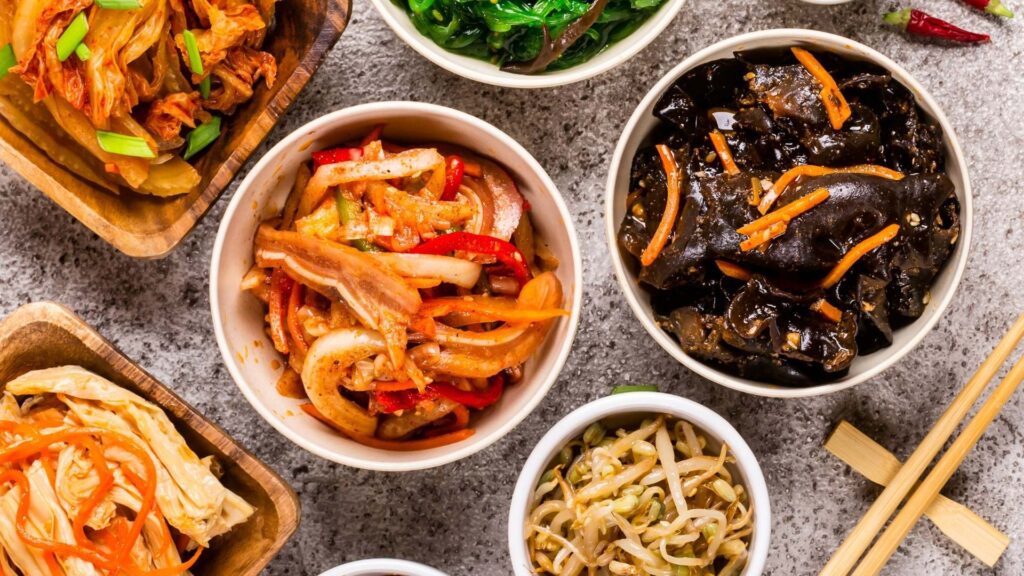
This article may contain affiliate/compensated links. For more information, please see our disclaimer here. We take all the efforts necessary to ensure the information included in this post is accurate, correct and current, sometimes, things just change! Travel information like opening hours, business operations and prices may change. If you find anything in this post that is incorrect or outdated, please let me know in the comments so I can update it for other readers. Cheers!
We love helping you plan amazing trips. If you need any of these services, consider booking them through our affiliate links. Without costing you anything extra, you will be helping support us so we can continue to write these blogs for you.
We thank you again for your continued support.
🏠 Find the perfect place to stay with Booking.com
✈️ Get the cheapest flights with Skyscanner
🚣 Book your favorite activities with Viator
💻 Make sure you have everything you need for your epic trip by checking our store on Amazon
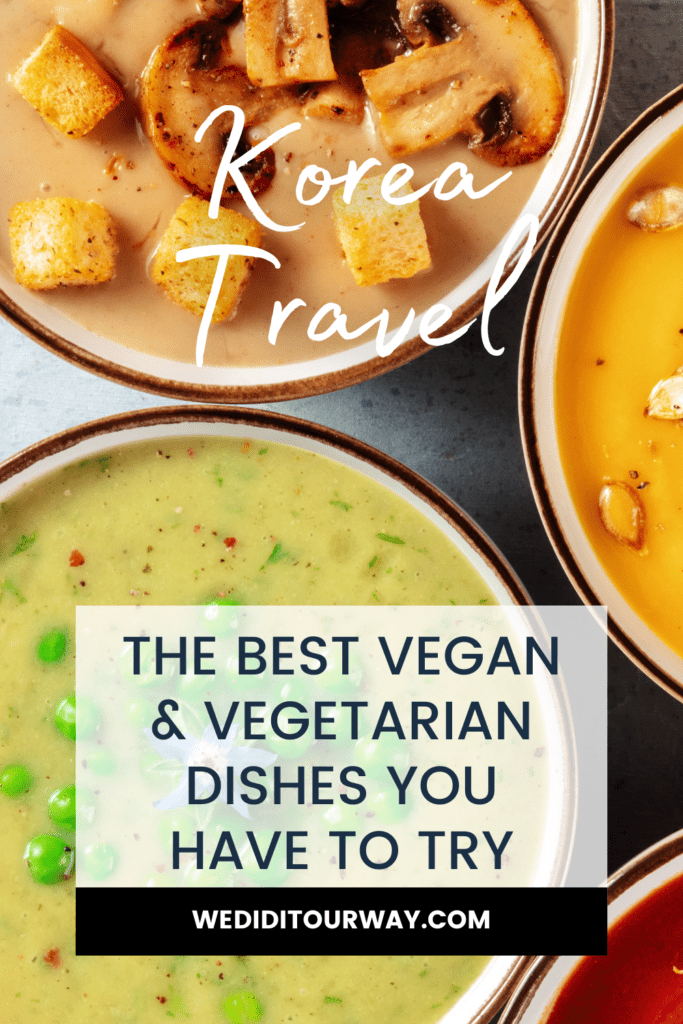
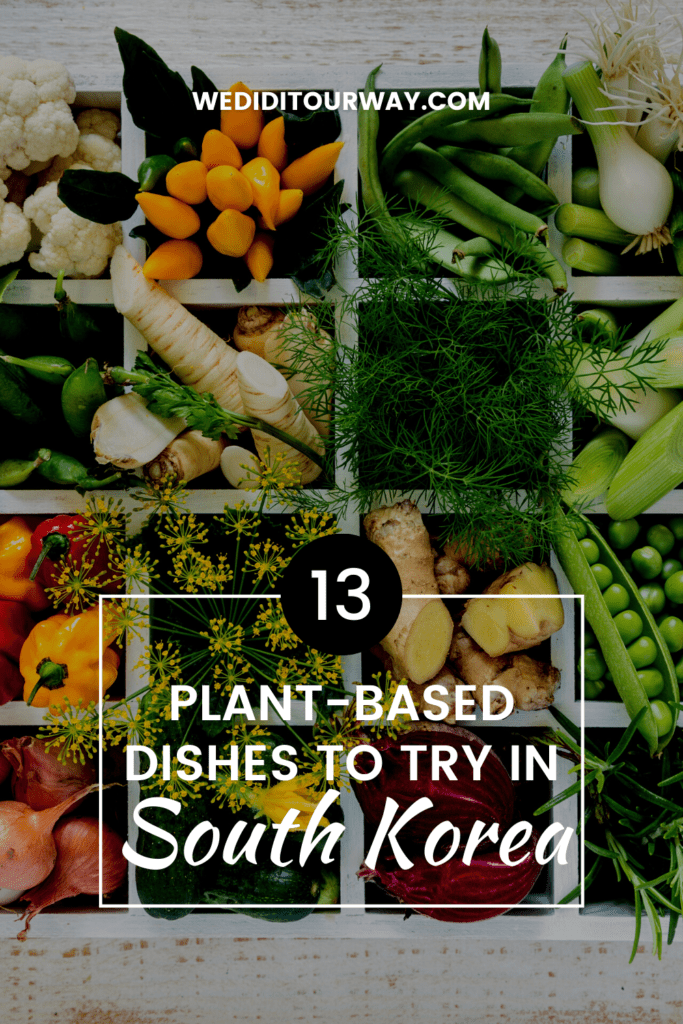
Table of Contents
The 13 best Korean vegan food & vegetarian dishes in South Korea you have to try
Despite sometimes being hard to find, there are some amazing vegan & vegetarian dishes in South Korea that are quite readily available. You just have to know about them first, because truth be told, sometimes, the menus in South Korea can be quite overwhelming to read, but especially, to understand.
To make your culinary adventure more enjoyable in South Korea, we asked our favorite bloggers to tell us their favorite Korean vegan food, vegetarian dishes in South Korea, but also, some of the best vegan-friendly restaurants in the country.
Let’s dig in and see what amazing culinary experiences are waiting for you in South Korea.
5 amazing vegan dishes in South Korea for plant-based travelers
If you want to stick with your dietary restricitons but still have some amazing vegan meals in Korea, there are plenty of options still available to you.
Let’s start first with some of the best plant-based, vegan options that you can have in South Korea.
1. Get full on Kimchi Mandu, a delicious plant-based Korean dish
Contributed by OllieAndTheCaptain.com
Our traveling duo consists of one adventurous foodie and one that is significantly more conservative. This has made our foodies’ experiences around the world rather entertaining.
On a recent trip to Seoul, the pair of us had a tough time reading the menus at restaurants and trying to figure out what exactly we were ordering. This caused a lot of frustration for us hungry travelers especially since finding vegan dishes in South Korea is hard.
That is until we discovered kimchi dumplings, locally known as kimchi mandu, which are sold at many Korean restaurants. A sure bet when you need some vegan Korean food!
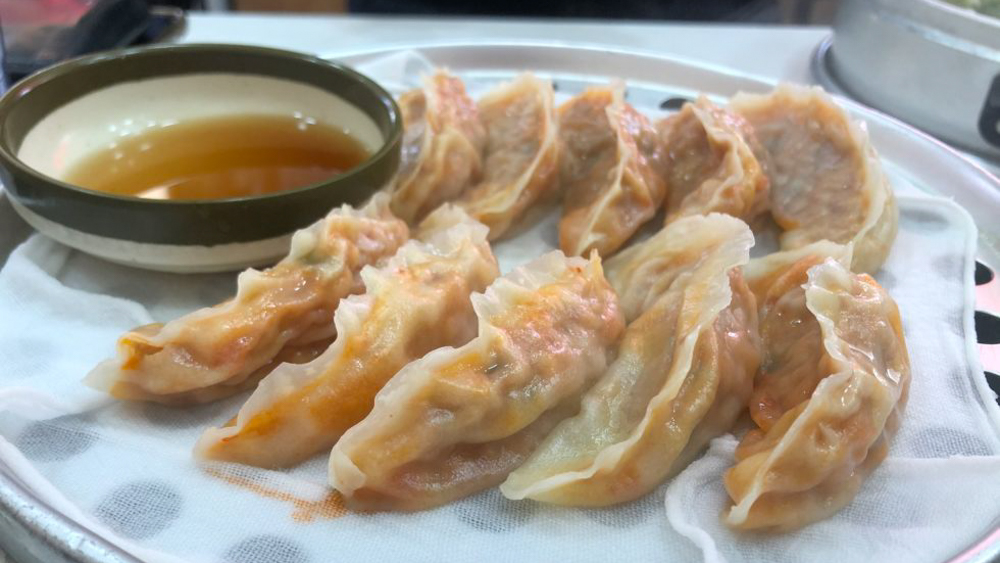
Our first taste of this spicey and wholesome vegan Korean dish was at a local restaurant in Mapo-Gu called Mapo Dumpling. After indulging in one meal there, we retraced our steps to this exact spot on a daily basis. The dish is typically served with soy sauce and a variety of side vegetables to add a little bit of crunch.
These delicious, bite-sized dumplings are not only savory and spicy in flavor but also offer an interesting contrast of texture. The combination of kimchi mixture, noodles and tofu is enough to fill you, without compromising your vegan diet.
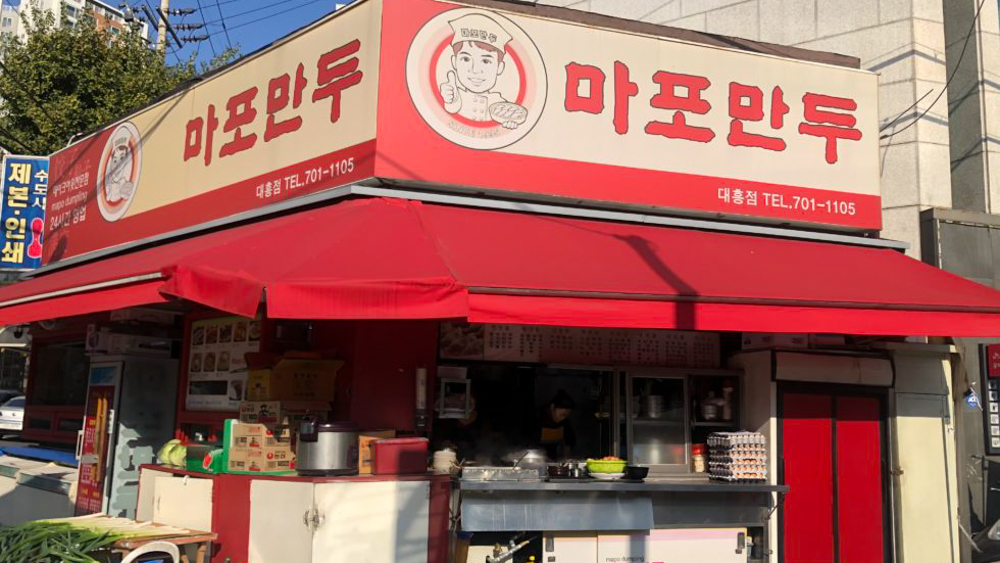
Be advised that Kimchi Mandu is not always a vegan dish. Some restaurants add minced beef, pork or egg inside their mixture. The tricky part is also the kimchi, as they often use shrimp extract or fish sauce. Always make sure that you double-check before ordering as everyone has different recipes.
2. Enjoy some hoddeok, a typical vegan street food in Korea
Contributed by DameCacao.com
Hoddeok (호떡), or “hotteok” is the quintessential winter street food in Korea, and a must-try when traveling in Seoul. It’s also a perfect vegan Korean food! Although some places use milk in them, so make sure you ask before ordering.
The gooey cinnamon sugar-filled rice cakes are formed into balls and then slapped onto the hot griddle, where they’re flattened and fried until crispy on the outside and melty on the inside.
The base for the street cakes is a glutinous rice flour common in Korean sweets; the “ddeok” in “hoddeok” is actually a reference to this chewy outer layer. The rice flour is mixed with water, salt, and sugar, and sometimes milk until the dough becomes sticky and thick. Are you starting to see how delicious this Korean vegan dish is going to be!?
You may see green-tinted versions of Hotteok made with green tea powder. Each ball of dough is filled with a cinnamon sugar & nut mixture, folded over, and fried on either side for just under a minute.

The vegan confection is served in a paper cone, and costs anywhere from ₩1000 to ₩3000 (~$0.80-2.50USD) depending on size, quality of ingredients, and where you buy it. The more touristy the spot, the more expensive the street food, though I actually had the best hoddeok of my life in the Insadong neighborhood of Seoul. Sellers can be seen populating the streets of Korea’s markets anytime there’s a chill in the air.
Hoddeok is most popular in the wintertime, from November to March when its heat generally doubles as a hand warmer (for as long as it lasts). If you’re lucky enough to find a hoddeok stand in the spring or fall, count your blessings and get in line.
Note that some places will use milk in their mixture or as a topping. Make sure you ask for a fully vegan option if that is what you’re looking for.
3. Sundubu-Jjigae (순두부찌개), a traditional Korean vegan stew
Contributed by PazookTravelJournal.com
Sundubu-Jjigae (순두부찌개) is a famous type of vegan stew in South Korea. If you’re looking to try a traditional vegan meal in South Korea, this is a great option.
The stew is made with uncurdled soft, silky tofu that melts in your mouth with each bite. The flavor is salty and savory, which comes from soy sauce, chili oil, and Gochugaru paste (Korean red pepper). You’ll also find mushrooms (enoki & shiitake), green onions, garlic, and soybean paste in the stew.
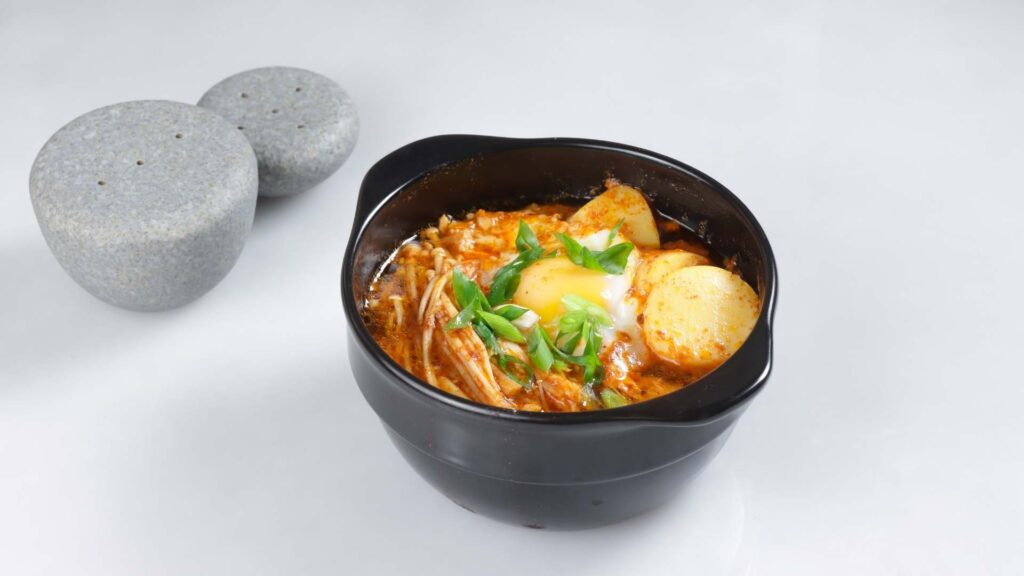
Many people add seafood (like prawns or littleneck clams) to the dish, but vegetation Sundubu-Jjigae is just as easy to find.
However, many recipes call for eggs, so finding a completely vegan Sundubu-Jjigae in Korea can be challenging unless you specifically request it.
You won’t find Sundubu-jjigae on the street. It’s a proper dish you can order at most traditional restaurants in South Korea.
Looking for something a little more traditional? Check out the 400-year Chodang Soft Tofu House in Gangneung for the most traditional Sundubu-Jjigaw in South Korea. The coastal city is known for its soft tofu stew, and this is the best restaurant to eat the stew in Gangneung!
4. Kalguksu, a traditional Korean vegan dish
Contributed by InMyKorea.com
Kalguksu is a traditional Korean dish that consists of knife-cut noodles in a bowl of steaming broth that’s perfect during cold Korean winter days.
There are many varieties of kalguksu and the original kalguksu is both vegan and vegetarian-friendly, if cooked without anchovy paste.
The star of this dish is the noodles, which should be hand cut by a knife and freshly prepared before being served in a hearty soup with a few vegetables for extra flavour, such as shiitake mushrooms or julienned carrots and zucchini. A generous helping of cilantro goes well with kalgusku, too.
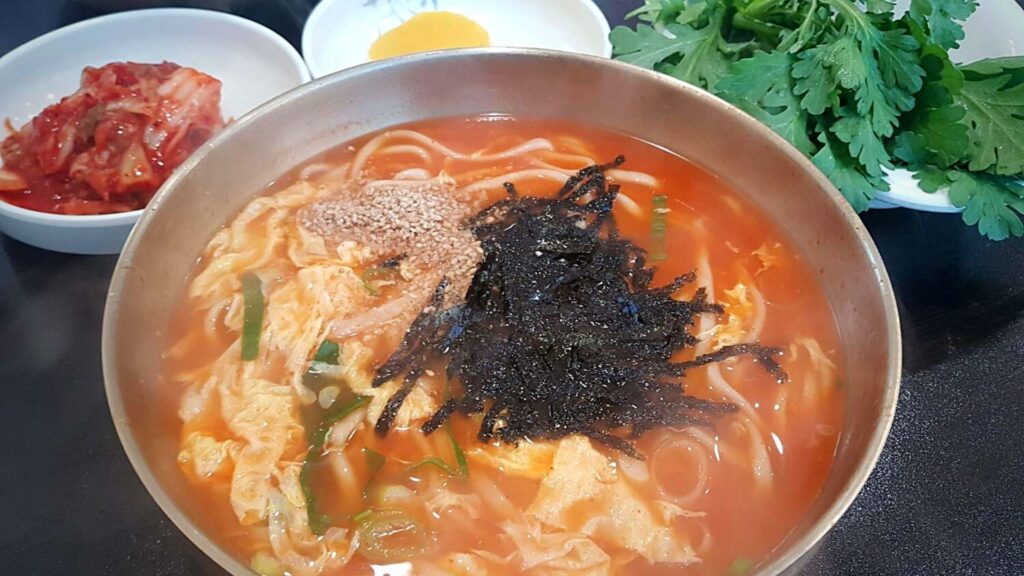
If you want to try kalguksu in Korea, the best place to experience an authentic bowl is a traditional Korean market, such as Gwangjang Market in Seoul. At these markets you’ll find chefs who specialize in this one dish, who cut, slice, and serve the noodles to you while you sit and wait for your meal. The noodles won’t look perfect like spun-out store-bought noodles – they’ll be thick, a bit wonky, and chewy in a tasty way.
Slurp the noodles straight down from the bowl and wash them down with the simple, yet powerful, hot broth. This is a messy meal, but one that will leave you feeling extremely satisfied at the end.
5. Japchae, a typical vegan-friendly dish in South Korea
Contributed by AwesomeTraveler.blog
Here are some international travel tips for foodies looking for vegan meals in South Korea.
When in South Korea, you should try their mouth-watering dish called Japchae. Japchae means mixed vegetables in Japanese. It is served during traditional holidays and special occasions. As a matter of fact, it is the most popular potluck dish in South Korea. And best of all, it’s a delicious dish for vegan and vegetarian alike.
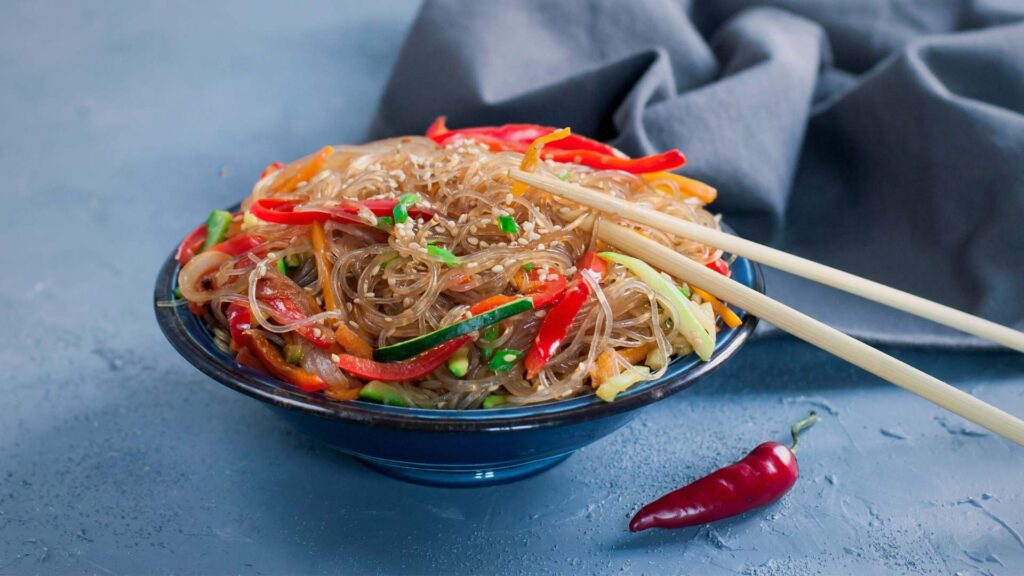
Japchae is made with sweet potato starch noodles, stir-fried vegetables, mushrooms, sesame oil, sesame seeds, soy sauce, spinach, green onions, carrots, garlic, red bell pepper, and black pepper.
For a healthier choice, I would suggest asking for more vegetables and fewer noodles.
Note that sometimes, japchae is served with meat. Make sure to ask for no meat added when you order this dish in a restaurant.
5 vegetarian dishes in South Korea to fill your appetite
If you’re a vegetarian traveling in South Korea, you’re in luck, because you’ll have quite a few more options to choose from. A lot of Korean dishes use eggs or milk in their recipes. Although some places have created vegan alternatives to these foods, sometimes, the vegetarian option is much closer to the original.
Here are some typical vegetarian dishes in South Korea you can enjoy during your time there.
1. Treat yourself to some Patbingsu, a delicious vegetarian dessert in South Korea
Contributed by KncycxJourneying.com
What is patbingsu? In Korean, “Bingsu” means shaved ice, and “Pat” means red bean. The word, literally, is “red bean shaved ice”.
While shaved ice isn’t new to food lovers, South Korea’s shaved ice has its own unique taste and style, making this a must-try vegan Korean dish.
A traditional patbingsu consists of fine and soft shredded ice with red bean paste (pat) and condensed milk. Today, the dessert is served with various exciting toppings that include seasonal fruits, azuki beans, tteok, yogurt, matcha sauce, and sometimes with a scoop of ice cream! The perfect vegetarian dessert dish in Korea!
Having a bowl of patbingsu is a popular culture among locals and it is spreading to the rest of Asia. There are many patbingsu shops in Seoul, especially Dongdaemun, Insa-dong, Myeong-dong, and Itaewon.
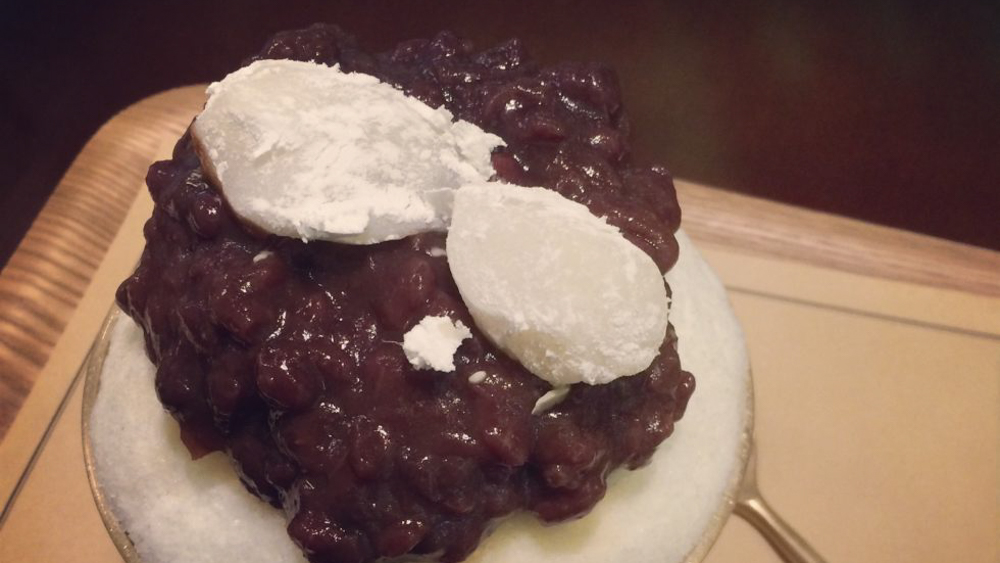
As for me, my favorite patbingsu is still the traditional kind, the soft texture of red bean and condensed milk complement each other, and the sweetness is softened by the cooling ice. Not only the dessert tastes great and is presented with colorful toppings, but also fun sharing a bowl of ice with a group of friends after a fun night out and dinner!
2. Go crazy on Bibimbap, a delicious South Korean vegetarian dish
Contributed by yours truly at WeDidItOurWay.com
This is our own go-to favorite vegetarian dish in Korea. The original version has meat in it, but often, you can ask for is “Gogi eob-si ju-se-yo” (Please give me without meat.) Or, Gogi mot-meo-geo-yo (I cannot eat meat) would be another way to say it. This will make it clear you want a vegetarian version.
Bibimbap is basically mixed rice. It’s a mixture of both rice and vegetables with a fried sunny-side-up egg on top. If you’re vegan, you can ask that the dish come without an egg.
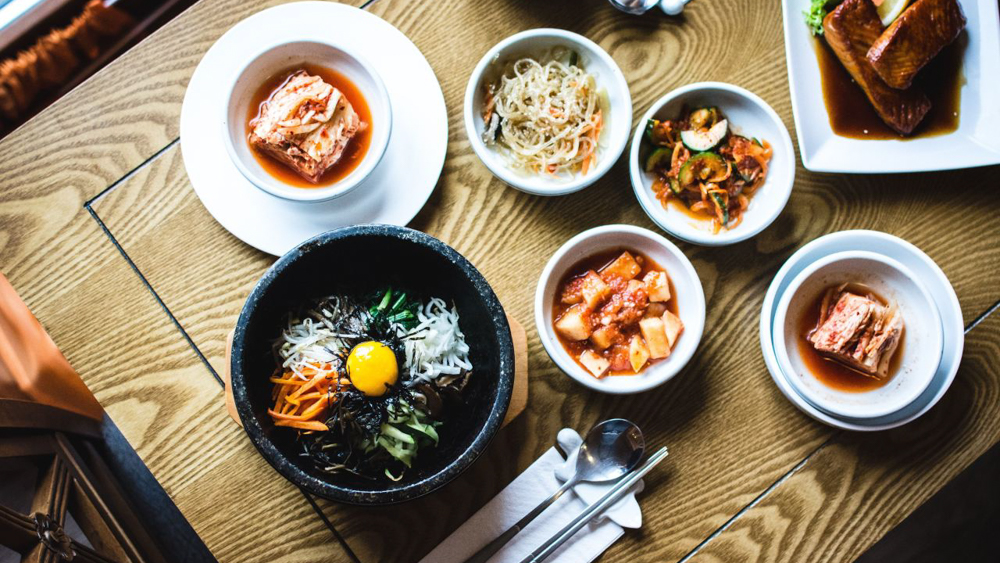
Bibimbap is a cheap dish and it’s quite easy to find in pretty much any restaurant. That’s why we would have it when we had lost all hope of finding any other vegetarian meals in Korea.
Knowing what food to order is only half the battle. There are plenty of other things to know to make sure you can eat healthy vegetarian or vegan meals in Korea without compromising on your dietary values. So we put together some tips to help you out.
3. Gimbap, a vegetarian meal to try in Korea
Contributed by TinyFootstepsTravel.com
Gimbap (pronounced “gim-bap”) is a Korean street food that can be found at many eateries around South Korea. Often called the Korean sushi or Korean rice roll, gimbap is a casual food that consists of seaweed paper wrapped around rice, and different filling options.
There are often meat versions of gimbap sold, but there is normally a vegetarian option as well that consists of seaweed, rice and vegetables; usually pickled radish, carrot and cucumber, and sometimes egg. The gimbap roll is often sprinkled with sesame seeds and enjoyed with a sweet and sour soy dipping sauce on the side.
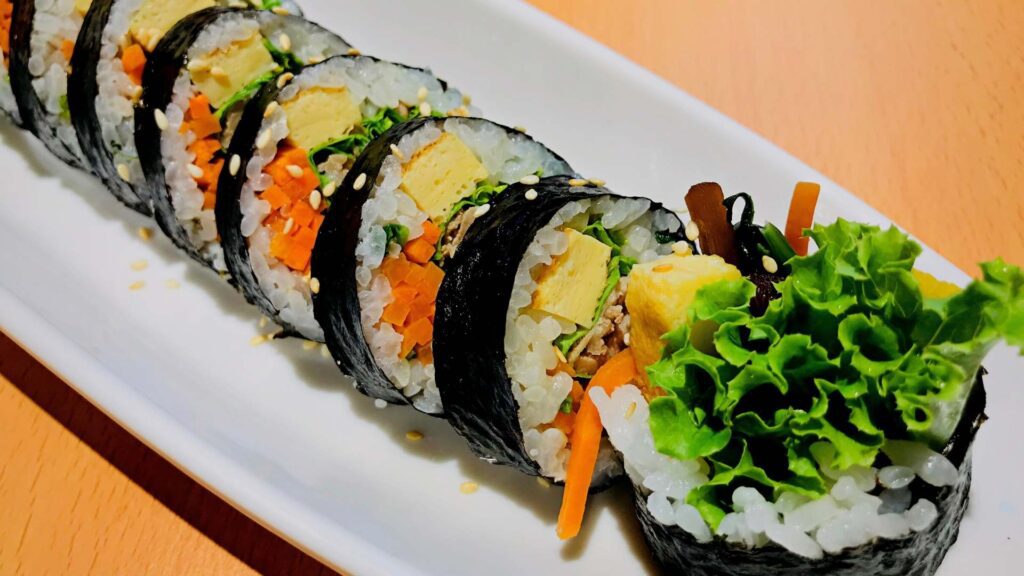
Gimbap is an affordable meal, usually never costing more than 4,000₩ ($3 USD) per roll. It’s a grab-and-go food that you can eat on a bench, or on the subway. The roll can also be sliced up, much like sushi maki, and enjoyed with a group of friends.
Gimbap can be very hard to find abroad, even in Koreatowns in other world cities. So be sure to enjoy this delicious vegetarian treat while you’re in South Korea.
Gimbap can also be made as a plant-based option, although it may not be as nutritious and filling as the vegetarian option which includes eggs. The vegan version will be stuffed with rice and various vegetables.
4. Pajeon, a delicious vegetarian meal in South Korea
Contributed by KnycxJourneying.com
Korean cuisine is enchanting because it has an exciting variety and genre. That’s why a food trip in Seoul is a rewarding experience because there’s always something interesting for everyone.
Pajeon is a vegetarian dish, yet it has no lack of character and taste. In fact, Pajeon is a rather common local dish that is served in many Korean food restaurants, whether it’s a Korean barbecue place, a traditional hansip restaurant, or a café.
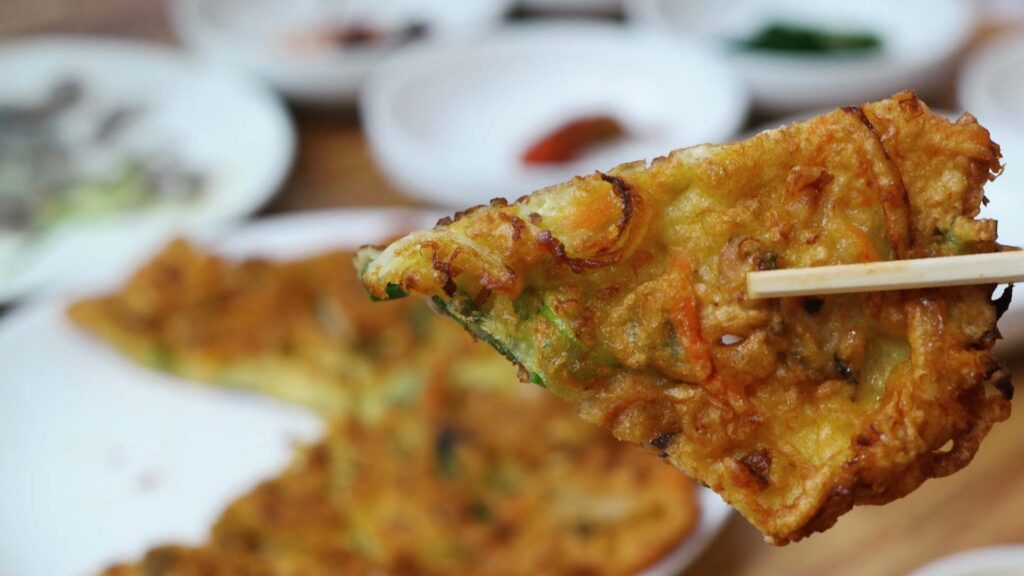
Pajeon is a pancake made with a mix of egg batter, scallion, and other ingredients. While beef, pork, or seafood are usually added to the recipe, the vegetarian version of Pajeon is with kimchi. It will often be found listed on menus as Kimchi-jeon, which is a similar dish with a different name.
“Pa” means scallion in Korean and therefore it is the key ingredient of the pancake. In Korean tradition, this is a homemade comfort dish because it’s simple and easy to make; it tastes good mixed with rice or soup.
At a restaurant, pajeon is sometimes served either as an appetizer, or main dish with rice. The most popular way to enjoy is with alcoholic beverages like Makgeolli.
Today, many cooks and restaurants are getting more creative to experiment with Pajeon with different ingredients – don’t be surprised if you find variations from cauliflower, mushrooms, shredded cabbage, bean sprouts, and many more.
5. Sujebi, a popular vegetarian meal in South Korea
Sujebi is a hand-pulled noodle soup that originated in Korea. It is a popular dish for Koreans to enjoy on rainy days or cold winters.
This Korean comfort food is an excellent option for vegetarians. The most common sujebi comes with potatoes and zucchini. But there are many other versions with various main ingredients, such as kimchi, potato, wild sesame, etc.
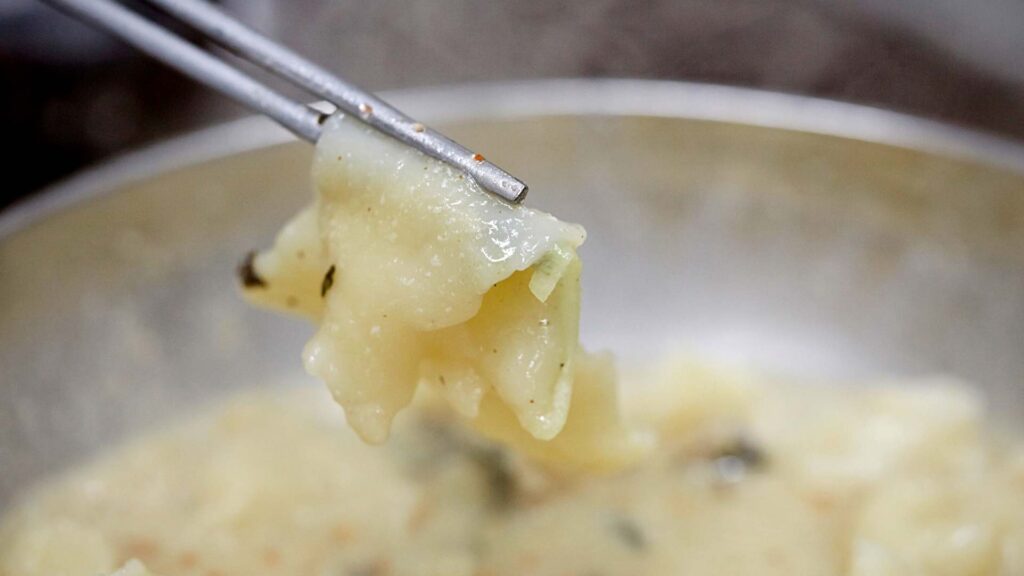
The “su” in Sujebi means hands. It requires a bit of labor as you have to knead and press the dough. Once you make the dough, you tear it off with your hand and drop it into the boiling soup. That’s why the noodles in sujebi are irregular and paper-thin. The texture is often chewy.
The key to flavoring is the hearty broth. It is usually made with kelp, dried anchovies, onions, garlic, and green onions. The fish sauce might also be added for flavoring. So if you are a vegan, check how the broth is made.
Sujebi is a common dish found in many restaurants across the country. But if you have Bukchon Hanok village in Seoul itinerary, swing by one of the most famous restaurants nearby, Samcheongdong Sujebi.
3 vegan-friendly restaurants in South Korea you have to visit
1. Have some Tteokbokki (떡볶이) at Maru JeYeonSik Kimbap in Seoul
Contributed by TheNomadicVegan.com
Tteokbokki is a classic Korean street food. You’ll often see it being sold at pojangmacha (wheeled street food stalls) all over the country. The name is often translated into English as “Korean rice cakes”, but don’t expect the type of cake that you would have for dessert. This is something completely different! And best of all, it’s a vegan Korean meal!
Made from rice flour, tteok come in a long, cylindrical shape and have quite a chewy texture. The tteok themselves may be slightly sweet, but the sauce they are served in is usually quite spicy. This dish is extremely popular as a late-night snack among the young bar-hopping crowd.
Even though tteok are totally vegan, unfortunately, the sauce they are cooked in often contains anchovy stock, and sometimes also fish cakes.
If you know some basic Korean, you can try asking street vendors if their sauce is vegan. Even though I had used a couple of language apps to learn some Korean before traveling to the country, when I first arrived in Seoul I still wasn’t too confident with my Korean skills.
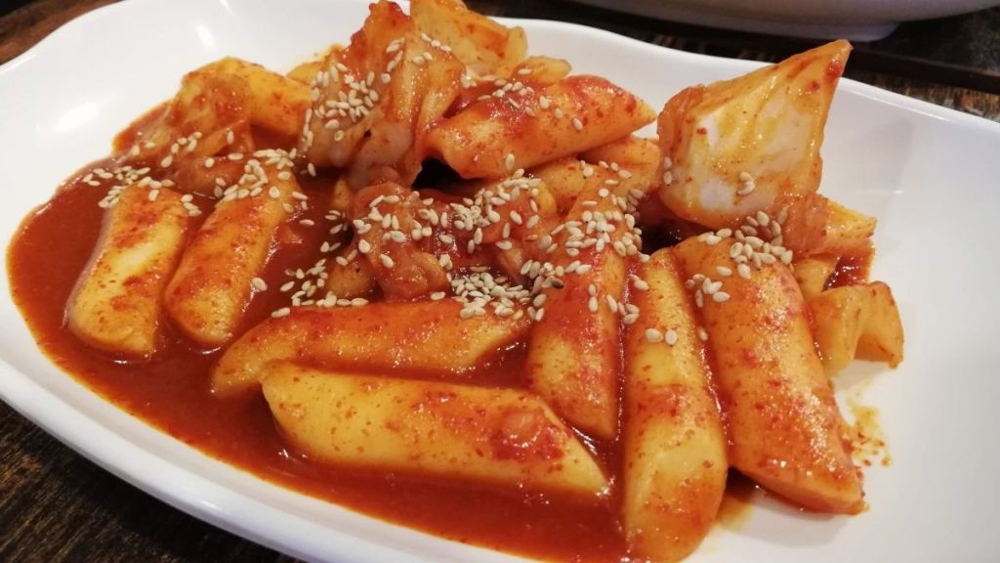
So I skipped the street vendors and instead went to a wonderful place called Maru JeYeonSik Kimbap, which makes completely vegan versions of lots of different types of Korean street food, including tteokbokki!
Located in the popular bar and restaurant district of Insadong, it was one of my favorite restaurants in all of Seoul. It’s a great place to go if you’re looking to try tteok and other traditional Korean dishes with a vegan twist.
2. When in Itaewon. eat at Plant, a renowned vegan restaurant in Seoul
Contribution by BeMarieKorea.com
Anyone will tell you that being vegetarian or vegan in Korea is not easy. Knowing where to go is so important. This is why you need to go to Itaewon, which has been known as the foreign district of Seoul. This is reflected in the restaurants you can find in this area. It has some of the best foreign food restaurants in the city and many vegan or vegetarian restaurants, which is rare in South Korea.
Ask anyone about the best Vegetarian/Vegan restaurant and they’ll definitely say PLANT. This restaurant and bakery serve 100% plant-based dishes.
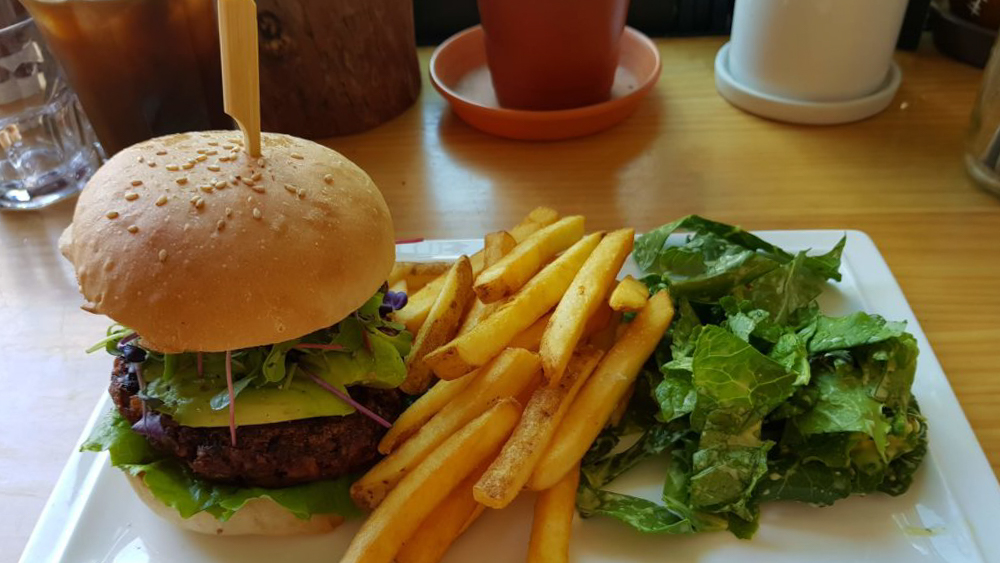
My personal favorite is the burger with fries but other dishes include falafel bowls, sandwiches and pasta dishes. Not only do they serve yummy vegan food, but they also have a wide array of drinks, like kombucha, juice, smoothies, beer, and ade.
The restaurant also sells come cakes, but a bigger variety of cakes can be found in their bakery, which is just a 5-minute walk away. In the bakery, the focus lies on selling gluten-free desserts, muffins, experimental sweets, bread, cakes, and scones.
So if you’re in Seoul and you need to get some vegan meals, you need to head here!
3. Sanchon Restaurant, a vegan restaurant in Seoul worth visiting
Contributed by MuseumOfWander.com
Sanchon Restaurant, in the heart of Insadong, is a must-visit destination for vegan and vegetarian travelers seeking a taste of Korean temple cuisine in Seoul. Beyond its delightful plant-based dishes, visiting Sanchon provides a delicious glimpse into Korean culture and traditions.
The restaurant was founded by a Buddhist monk who aimed to share his passion for temple food with others. Sanchon’s commitment to using seasonal ingredients shines through in its menu, which includes wild mountain herbs and foraged plants, ensuring a fresh and unique dining experience.
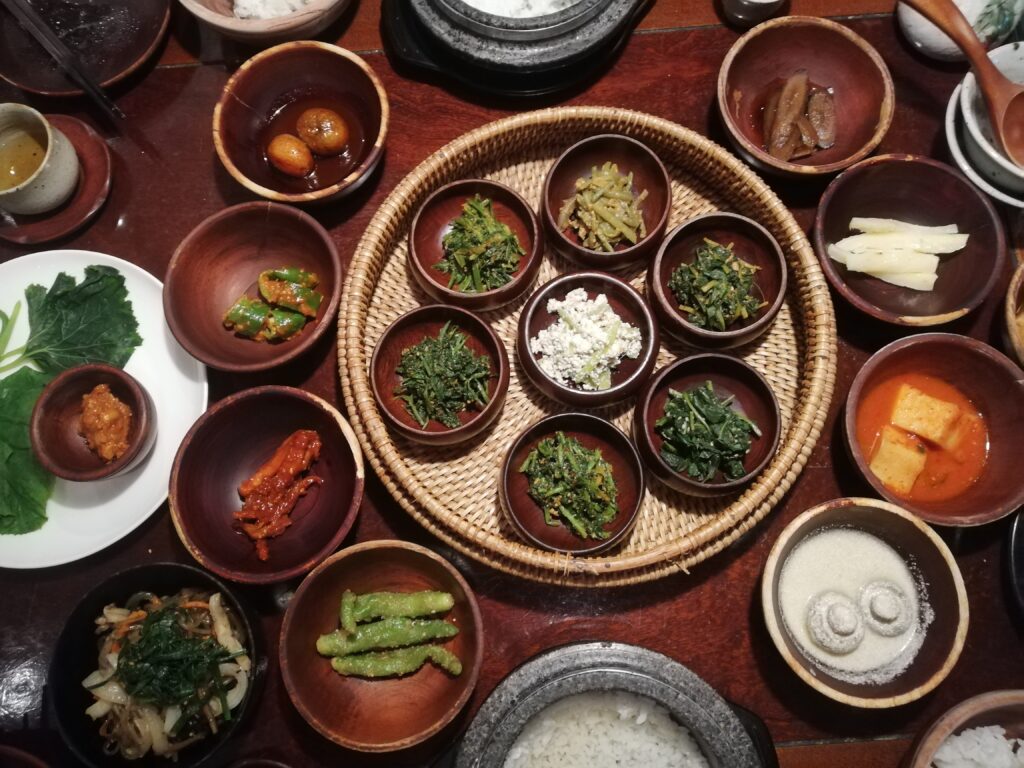
At Sanchon, diners do not choose from a menu but enjoy a set meal, which can best be described as a vegan feast. This indulgent meal consists of 16 beautifully presented dishes, showcasing the diversity and creativity of temple cuisine.
As you sit cross-legged on the floor amidst the restaurant’s lush greenery and exquisite wooden details, a sense of fulfillment and tranquility envelops you while you savor each bite of the vegan feast.
The set meal includes an array of banchan (side dishes) such as kimchi, japchae (sweet potato noodles), peppers, garlic stems, soups, and many dishes that probably don’t even have English names.
Even if you’re not vegan or vegetarian, visiting Sanchon is an extraordinary dining experience that should not be missed on your Seoul itinerary.
4 tips for being vegetarian or vegan in South Korea
Anyone will tell you that Korea is a meat lover’s paradise. Every restaurant will offer you a variety of meats and seafood, but rarely will they have anything remotely close to being vegetarian, let alone vegan! So make sure you watch out for these things:
1. Be specific as to what you can and cannot eat as a vegan or vegetarian in Korea
Like in most countries where the diet is very meat-heavy, vegetarian often means you don’t eat a certain type of meat, usually pork or beef. This means that chicken, seafood, and fish are not considered meats. So even if you tell them you’re vegetarian or vegan and that you don’t eat meat, you may end up with meat in your dish.
That’s why you shouldn’t just say you’re vegetarian or vegan in Korea. Instead, be really specific as to what you can and cannot eat. Ask them to tell you exactly what is in the dish. Ask if there is meat, chicken, fish or eggs in the meal. This way, there is no bad surprise when your plate shows up.
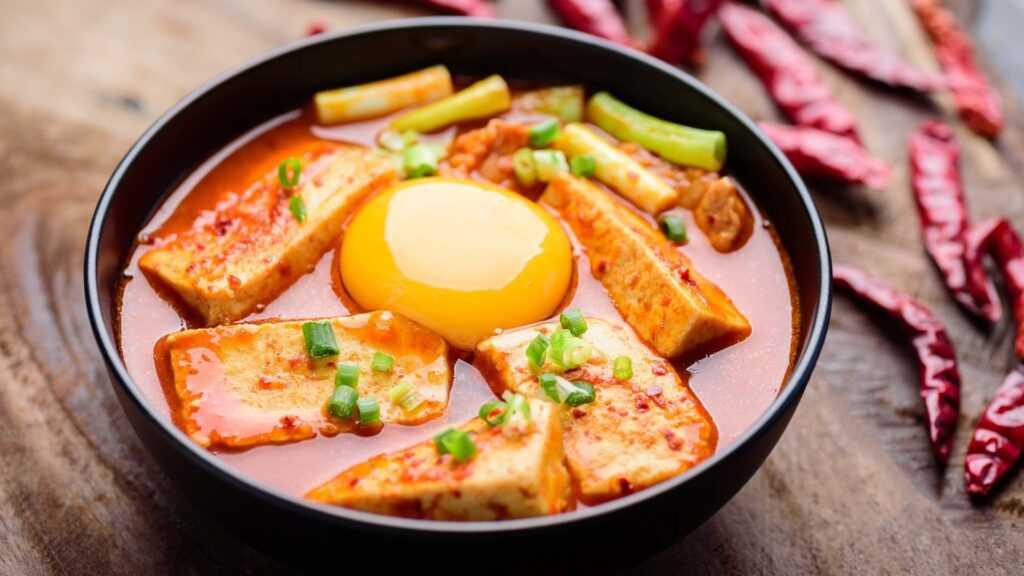
2. Check out the side dishes for good plant-based options
Like in most meat-heavy cultures, side dishes tend to be more vegetarian-friendly or even vegan. So before you cross a restaurant off your list, make sure you take a look at the side dishes. You’ll be able to put a decent meal together that works with what you eat!
3. Have your go-to vegetarian and vegan Korean dishes
At one point during our 5-week trip, we got tired of hunting down new vegetarian dishes in Korea. Instead, we decided to stick to the classics we know won’t cause any issues.
For us, they were the bibimbap, and Korean pancakes made with sweet potatoes – these were our favorite vegetarian dishes that we first discovered in a market in Busan. Sometimes, if we were lucky, they would even have vegetarian Kimbap (Korean sushi).
As soon as we saw that they had these on their menus, we would stop searching for food, because far too often, we wouldn’t end up finding any good vegetarian Korean dishes.
4. Learn some basic Korean language
We were lucky enough to start our Korean trip by staying with Couchsurfers who taught us some basic Korean sentences to use in restaurants to make sure we could get some vegetarian food. Here are a few that may be useful to you:
- I’m a vegetarian: jeo-neun chae-shik haeyo
- I don’t eat meat: gogi an mo-geo-yo
- No meat: gogi abshi
- Just rice and vegetables please: bap-e-rang ya-chae-man juseyo
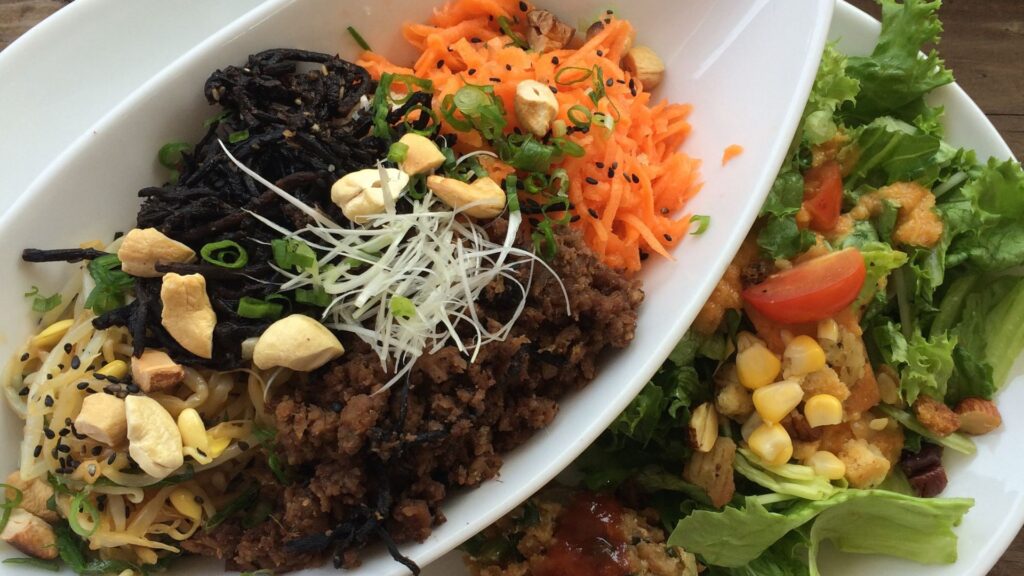
The 13 best vegan and vegetarian meal options in South Korea
As a reminder, here are the best korean vegan dishes, vegetarian foods and plant-based restaurants in South Korea:
- Kimchi Mandu
- Hoddeok
- Sundubu-Jjigae
- Kalguksu
- Japchae
- Patbingsu
- Bibimbap
- Gimbap
- Pajeon
- Sujebi
- Tteokbokki at Maru JeYeonSik Kimbap
- Plant Restaurant in Seoul
- Sanchon Restaurant in Seoul
Hopefully, knowing these dishes and tips will help you have more ease in finding vegan & vegetarian dishes in South Korea. For sure, being vegetarian or vegan has its challenges regardless of where you are in the world, but Korea has an added layer of difficulty. As long as you know what to look out for, and how to pick good options, you’ll be golden!
Let us know in the comments what your favorite vegetarian and vegan dishes are in South Korea. Did we miss any places? Should we add any other dishes or restaurants?
Thank you so much for reading the article all the way through!
We put a lot of time and effort into the content we create. Please like, comment and share – every action on your part helps us out tremendously and is very appreciated.
You can also help us by pinning this article for others to find.
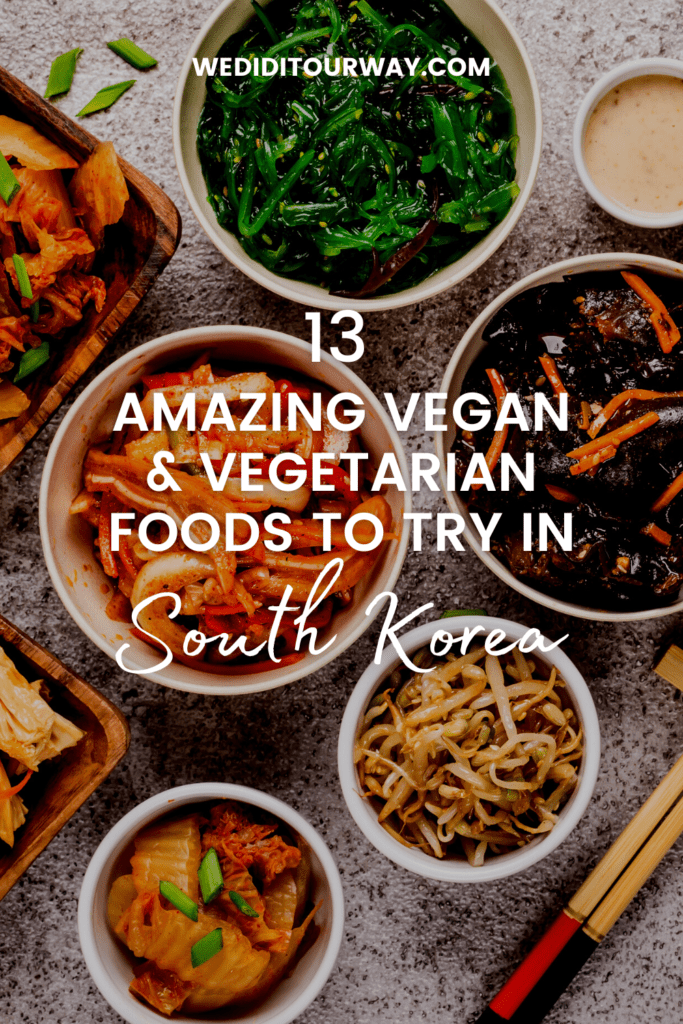
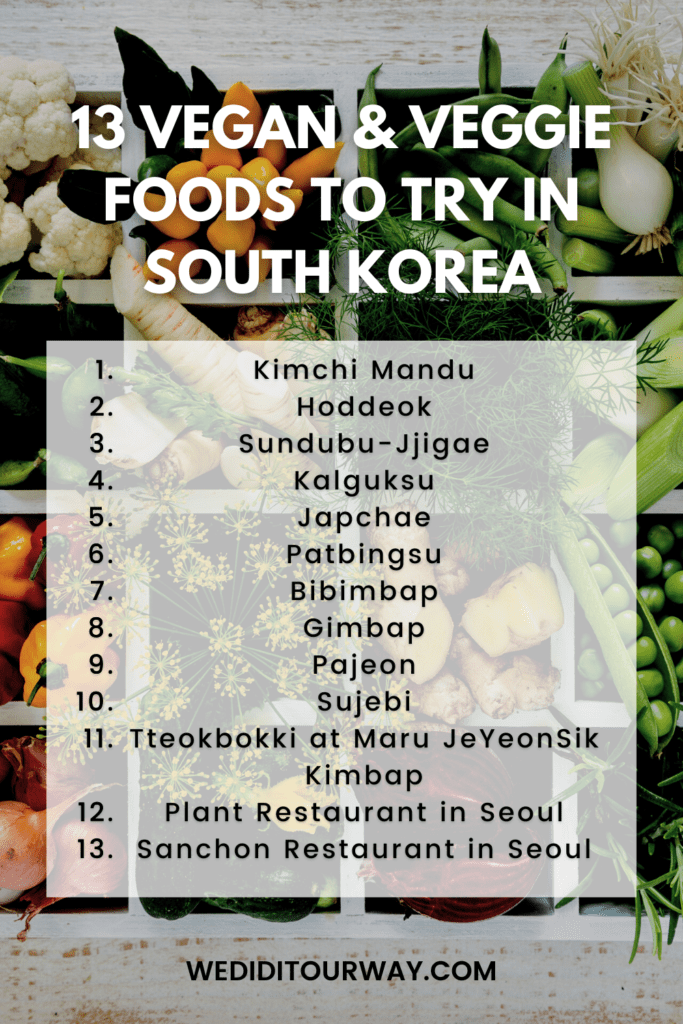
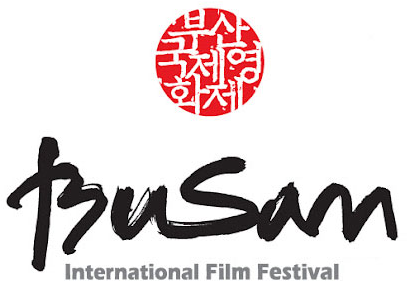





0 Comments